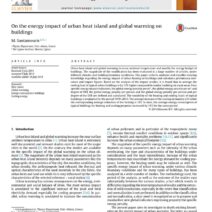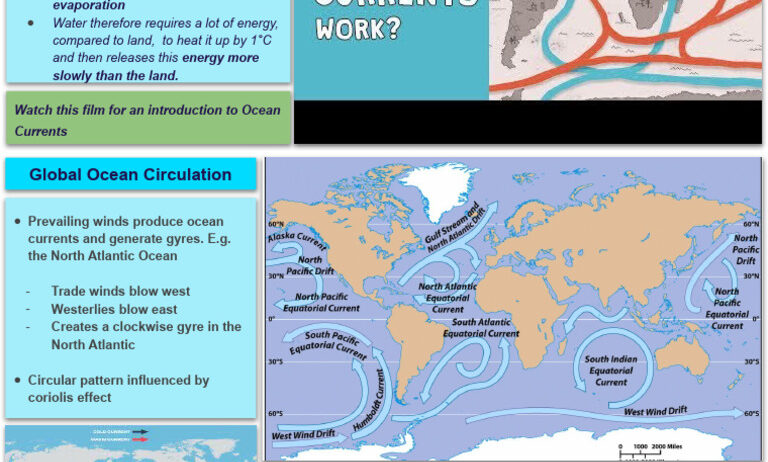Ocean currents play a pivotal role in shaping the climate of different regions across the globe. These currents, which are vast streams of seawater driven by wind, Earth’s rotation, salinity gradients, and temperature differentials, act more than just highways for maritime navigation. They are intricate systems linked together in a tapestry that profoundly influences weather patterns, temperatures, and, consequently, life as we know it.
The movement of ocean water is primarily driven by the sun’s energy, which warms the surface of the ocean, resulting in a decline in water density. Warm water, being lighter, rises while cooler, denser water sinks. This phenomenon sets up a convection cycle that creates various surface currents. The Coriolis effect, stemming from the Earth’s rotation, further complicates these currents, governing their direction and velocity. Thus, understanding the mechanics behind ocean currents is essential to deciphering the climate variations across different geographical locales.
Regional climates are largely influenced by ocean currents through heat distribution. For example, the Gulf Stream, a potent current in the Atlantic Ocean, transports warm water from the equator towards the North Atlantic. This not only moderates the climate of Western Europe but also contributes to milder winters in countries like the United Kingdom and Norway. Conversely, regions that are situated away from these warm currents, such as parts of Canada, experience much harsher winters, highlighting the stark contrasts driven by oceanic flows.
Moreover, ocean currents are integral to the global carbon cycle. They facilitate the transfer of carbon dioxide between the atmosphere and ocean. As surface waters absorb CO2, water from the depths rises to the surface in a process known as upwelling, leading to nutrient-rich waters that support marine ecosystems. The capacity of these currents to sequester carbon is vital in mitigating climate change, emphasizing their ecological significance.
In addition to heat and carbon cycling, ocean currents significantly impact precipitation patterns. Regions adjacent to warm currents often benefit from increased seasonal rainfall, fostering lush ecosystems. Conversely, areas influenced by cold currents can enter periods of drought. For example, the California Current, a cold oceanic flow, influences climate conditions along the West Coast of the United States. Its cooler temperatures contribute to a Mediterranean climate, characterized by dry summers and wet winters, impacting agricultural practices and water availability.
As we delve deeper into the significance of ocean currents, their interplay with extreme weather phenomena becomes apparent. Changes in ocean current patterns can precipitate drastic shifts in storm frequencies and intensities. The interplay between the Atlantic Meridional Overturning Circulation (AMOC) and storm tracks illustrates this industrial symbiosis. Recent studies have shown that a weakened AMOC, due to climate change, may lead to more extreme weather patterns, including hotter summers and harsher winters, as well as an increase in hurricane activity along the East Coast.
Furthermore, the interaction of ocean currents with topographical features is critical in shaping localized climates. Coastal upwelling zones, where deep, nutrient-rich waters are brought to the surface, have profound implications for marine biodiversity. These areas support abundant fisheries, which are vital for food security in many coastal nations. The displacement of current patterns, however, can endanger these ecosystems, leading to dire consequences for both marine life and human populations dependent on these resources.
As the climate crisis continues to evolve, the resilience of ocean currents becomes increasingly important. Understanding the responses of these currents to global warming, melting ice caps, and changing salinity levels is essential for predicting future climatic changes. The current trajectory suggests that these currents may become less predictable, resulting in a cascade of effects on regional climates and weather systems worldwide.
In summary, ocean currents serve as conduits for heat distribution, carbon cycling, and precipitation patterns, intrinsically connecting marine and terrestrial ecosystems to the climate narrative. Their significance cannot be overstated, as they influence not only regional climates but also global weather systems, impacting life on Earth in diverse and intricate ways. To fully grasp the gravity of climate change, it is imperative to recognize the role of these currents as architects of weather and climate. By fostering a deeper understanding of ocean currents and their implications, humanity can approach climate action with a more informed perspective, ultimately working toward a more sustainable future.
As you observe the waves undulating across the vast oceans, consider the significant currents lurking beneath the surface. These unseen forces are almost like the Earth’s lifeblood, controlling temperatures and weather in a delicate balance. Acknowledging their importance sparks a crucial curiosity in the quest for climate awareness and environmental stewardship. It is through grasping the intricacies of these currents that humanity can champion efforts to protect and sustain our planet.






